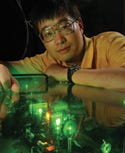Relying on a Breath of Detection
April 1, 2008
R&D DIGEST
|
University of Colorado physics professor Jun Ye is developing a very sensitive patient breath analyzer that could detect both heart and kidney disease. |
A sensitive laser system that analyzes human breath isn't just a bunch of hot air. Upon exhaling into the device, a patient could quickly be informed of potential health problems, from asthma to lung cancer. The low-cost and noninvasive technology could be a valuable preventive medicine tool.
The device is giving researchers the power to identify certain disease biomarkers from billions of other types of molecules. It is being developed by a team of researchers at the Joint Institute for Laboratory Astrophysics (JILA) of the National Institute of Standards and Technology (NIST) and the University of Colorado (Boulder).
The technology can be applied anywhere that trace amounts of gas must be monitored. In the medical field, it could identify diseases associated with the lungs. This includes kidney disease and heart disease. Heart disease sometimes results in a change in breath patterns, according to Jun Ye, a joint physics professor at the University of Colorado.
The technology has three components—the laser, the cavity (where the laser interacts with the material), and final analysis instrumentation. Although the complete package measures 4 × 3 × 2 in., it could also be engineered smaller.
The device uses a technique called cavity-enhanced direct optical frequency comb spectroscopy. A laser emits a train of short optical pulses, which creates a rainbow of colors with sharp spectral resolutions underneath. Upon zooming, the researchers can see individual components of optical frequency.
The laser is placed into an optical cavity, which allows the light to bounce back and forth so that it interacts with the material.
The laser emits many different colors, so there are hundreds of thousands of channels working at the same time. Researchers can sort through the colors by wavelength while maintaining very high resolution. “We can use individual components of these frequencies underneath the color as an individual detection channel,” says Ye.
Researchers can identify species in real time using the technology's high-spectral resolution. Its large spectral coverage and sensitivity helps them see many different types of molecules all at once. Having the ability to simultaneously detect many breath molecules could help them gather reliable, disease-
specific information.
The researchers are currently trying to improve the device's sensitivity. “We're working on [increasing] sensitivity by a factor of a hundred or maybe even a thousand, so we can detect molecules out of a trillion others,” says Ye. “We want to start analyzing the correlation between the breath and the real disease from real patients.”
Current testing has only involved healthy people. Ye hopes to apply it to clinical trials within a year. He says that companies and doctors have already expressed interest in both developing and commercializing the technology.
The research findings were published in a recent issue of the journal Optics Express. Funding was provided by the Air Force Office of Scientific Research, Agilent Technologies Foundation, the Defense Advanced Research Projects Agency, NIST, the National Science Foundation, and a University of Colorado grant.
Copyright ©2008 Medical Device & Diagnostic Industry
About the Author(s)
You May Also Like


.png?width=300&auto=webp&quality=80&disable=upscale)
